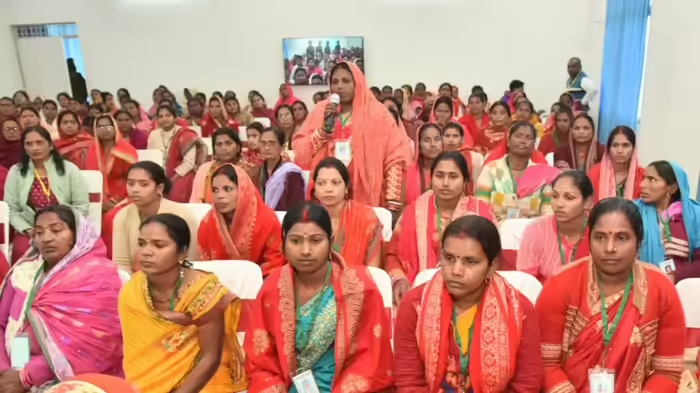
Patna | Bihar Voting 2025:
The first phase of the Bihar Assembly Election 2025 witnessed an unprecedented voter turnout of 64.66% — the highest in the state’s electoral history. But behind this historic participation lies a powerful force that could swing the results either way — the ‘Jeevika Didis’, a network of empowered rural women who form one of Bihar’s largest organized voting blocs.
With over 1.4 crore members, these women represent nearly 40% of Bihar’s 3.5 crore female voters. Once confined to household roles, they now stand as self-reliant contributors to their families and communities — a transformation credited to the state’s flagship ‘Jeevika’ livelihood mission.
“Earlier, we lived under our father’s or husband’s identity. Today, society knows us as ‘Didis’. We are independent and respected,” says Aarti Devi, a skill-extension worker from Nandan village in Buxar district.
How the Jeevika Network Works
In Nandan Panchayat alone, there are 70 Self-Help Groups (SHGs) comprising nearly 1,000 women. Across Bihar, thousands of such SHGs form the foundation of the Jeevika movement. Each group typically has 7–15 women members, all married women from local households.
They begin with small weekly savings — as little as ₹5 or ₹20 — and gradually establish their own financial rules and community funds. Within 60 days of formation, every SHG opens a bank account. Members also participate in village-level organizations that elect their own board of directors, ensuring representation for Scheduled Castes, Extremely Backward Classes, and Other Backward Classes.
These local bodies meet monthly, while larger cluster-level federations oversee multiple SHGs — creating a democratic, decentralized women’s network spread across Bihar’s villages.
Women Who Once Needed Support, Now Offer It
From running hospital kitchens to maintaining cleanliness at health centers, Jeevika Didis are now active partners in public welfare. Their appointments are made through village federations — free from direct government interference — ensuring autonomy and community trust.
The Nitish Kumar government has linked Jeevika Didis with nearly all women-focused welfare schemes — including Balika Scholarship Yojana, Kanya Utthan Yojana, Mukhyamantri Vivah Yojana, Inter-Caste Marriage Incentive Scheme, and Kasturba Gandhi Residential Program.
Divided Loyalties — Nitish’s Work vs. Tejashwi’s Promise
For many women, Nitish Kumar’s long-standing women-oriented policies still carry weight. As Bhagmanee Yadav, a Jeevika Didi from a Yadav family, says:
“I finished high school in 2010 with the help of Nitish Kumar’s cycle, uniform, and scholarship schemes. Today, I earn through Jeevika and pay for my children’s education. I have financial freedom — something my mother never had.”
Yet, the opposition led by Tejashwi Yadav has been actively wooing this same voter base with promises of better job opportunities, higher honorariums, and direct welfare transfers.
1.4 Crore Women — Bihar’s Silent Electoral Force
Political analysts believe that the record turnout owes much to the silent mobilization of these women voters. Their loyalty could tilt the balance between the ruling NDA and the RJD-led alliance.
As Bihar awaits results on November 14, one question dominates every political discussion —
“In whose favor did the Jeevika Didis press the EVM button — Nitish or Tejashwi?”
Discover more from SD NEWS agency
Subscribe to get the latest posts sent to your email.
